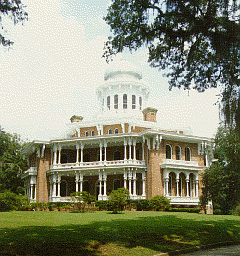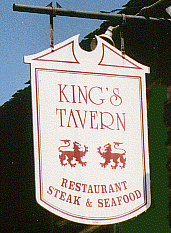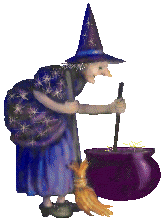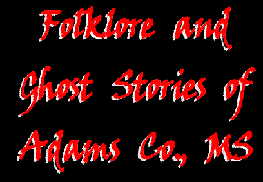|
The
Goat Castle Murders
,-.
Dr. Nutt of
Longwood
,-.
The Ghost of
Kings Tavern
,-.
Home
,-.
THE GOAT CASTLE
MURDERS -
There was blood, and the mistress of Glenburnie
was nowhere to be found, that hot August night in 1932 - but there was
no corpse. Bloodhounds were brought in to assist police and a large search
party of prominent Natchez citizens. Finally, early in the morning, the
bullet-ridden body of Jane SUGET MERRILL, Miss Jennie to locals, was found
in a thicket about 100 yards from the house.
Miss Jennie was the town recluse and eccentric.
Born in 1864 to a wealthy and prominent Natchez family, Miss Jennie spent
her early years as a popular socialite in Natchez, New York, and France.
In 1904, using a portion of the one-quarter-million-dollar estate left
to her, by her father, Miss Jennie purchased the old estate of Glenburnie,
and from then on became more and more of a recluse. She refused to
update her house, never installing electricity. She did buy an old Model
T, but while she could be seen puttering around town in the old car, she
would not enter or shop in the local stores. Instead, she would tap the
horn, and a saleslady would come out to the car.
Miss Jennie was 68 years old at the time of
her murder. She had never married, and only allowed one person to enter
Glenburnie during the 28 years she lived there. That one person was her
cousin, the equally eccentric Duncan C. MINOR, who visited Miss Jennie
every evening. It was thought that Duncan was the mysterious caller who
notified police of the blood, and disappearance of Miss Jennie, that fateful
August night. It was also rumored that Miss Jennie and Duncan had been
in love, perhaps lovers, for years. But no one knows, and the secret was
buried with them.
Duncan was not much of a suspect, but Miss
Jennie's neighbors were. Richard "Dick" DANA and his companion, friend,
and caregiver, the spinster Octavia DOCKERY, were immediate suspects.
Dick Dana, once a popular figure in Natchez, had suffered declining mental
health, over the years, and depended upon Octavia to care for him.
Octavia was herself, something of an eccentric. Neither had any source
of income, so Octavia began raising farm animals on the grounds of their
old house, Glenwood, which had been inherited by Dick, from his parents.
Chickens, geese, and goats roamed about the yard, sometimes finding their
way to the porch of the old structure that was badly in need of repair.
And so it was that Glenburnie became known as The Goat Castle.
Sometimes the goats ventured next door, to
the flower beds belonging to Miss Jennie. At one point, Miss Jennie purchased
a rifle and a handgun, and it is thought she shot and killed several goats
as they enjoyed lunch. Duncan tried to help. He made plans to purchase
The Goat Castle, by paying the back taxes, so he could evict Octavia and
Dick. However, Octavia had Dick declared insane, and as such, Dick could
not be forced to leave his home. The couple remained, the goats remained,
and the house continued to deteriorate, inside and out.
Another suspect was John GEIGER, a tenant who
lived in a shack, on the Dana property, called the Skumk's Nest, . His
overcoat was found in The Goat Castle, supposedly left as collateral for
back rent. However, when fingerprints belonging to both Octavia and Dick
were found at Miss Jennie's home, the poverty-ridden couple was arrested.
Miss Jennie had left a will. Her entire estate,
consisting of $250,000 in cash, Glenburnie, and two large plantations in
Louisiana, was left to Duncan. Only one notation was made, in the will:
"I am sure he [Duncan?] will carry out my wishes."
Octavia and Dick both loudly proclaimed their
innocence. They reported hearing loud noises coming from the Glenburnie
residence, on the night of the murder. Police were not convinced, and so
Octavia and Dick were arrested, and taken to jail.
For the first time in years, outsiders entered
The Goat Castle. Visitors were aghast at the filth and squalor. The once-beautiful
mansion had become home to the hordes of chickens, ducks, geese, and goats
that had been allowed to roam at will, making themselves comfortable among
the magnificent furnishings. A leather-bound set of books, and several
manuscripts, once belonging to the likes of Robert E. LEE and Jefferson
DAVIS, had been chewed to pieces. Wallpaper had come loose, and was left
to hang from the walls. Bedding and upholstered furniture had become moldy.
Neither Octavia nor Dick slept in the fine four-poster beds, preferring
filthy mats that had been placed on the floor in their respective bedrooms.
The police thought sure they had the murderers.
Then, a twist to the story. Several miles away,
in Arkansas, a man named George PEARLS had been shot and killed by Pine
Bluff police. Pearls had brandished a .32 caliber gun, the same type of
gun that had been used to murder Miss Jennie. Natchez townspeople began
to wonder, and their questions soon turned to sympathy for Octavia and
Dick. A jury could not be formed, and with the help of Ed RATCLIFF, a prominent
Natchez attorney, Octavia and Dick were released from jail.
Finally there was a confession. Emily BURNS,
a Natchez resident who owned a rooming house, admitted that she and George
Pearls had visited Miss Jennie in an attempt to obtain a loan. Miss Jennie,
angry over the intrusion, had drawn her pistol. It was then than Pearls
shot her. Other evidence collaborated the story, and Emily was convicted
and sent to prison.
Emily Burns spent less than eight years, in
prison, obtaining a pardon by Gov. Paul B. JOHNSON, Sr., in 1940.
Duncan Minor accepted his inheritance, bought
a new car, and traveled. At his death, money remaining from the inheritance
was left to Miss Jennie's family, presumably in accordance with her wishes.
And what about Octavia and Dick? Their lives
took a definite turn for the better. For a fee of .25, visitors could
tour the grounds; for another .25, visitors could actually enter The Goat
Castle. Dick, who once held a promising musical career, took a bath, shaved,
and entertained guests by playing a borrowed piano.
Dick Dana died in 1948, a few months before
Octivia's death in April, 1949. The Goat Castle was left to out-of-town
cousins who auctioned off most of the furnishings. The house was abandoned,
and finally torn down in 1955.
Glenburnie, the home of Miss Jennie, was eventually
restored and updated.
,-.
Bibliography:
The Goat Castle Murders by
Sim C. Callon and Carolyn Vance Smith, Plantation Publishing Company, Natchez,
Mississippi, 1985
Natchez on the Mississippi by
Harnett T. Kane, Bonanza Books, New York
Return to
Index
DR. NUTT OF
LONGWOOD -
"I had a choice. I could allow Dr. Nutt
to scare me away from Longwood, or I could let him know who was boss."
Several stately homes were built, in Adams
County, during the early to mid-1800's. Longwood, the largest octagonal
house in America, was one of them. In 1860, Dr. Haller Nutt, a wealthy
cotton plantation owner, began construction on an estate for his beloved
wife, Julia, on the old Longwood plantation located at the southern edge
of Natchez. War was approaching, but, foolishly, Dr. Nutt did not delay
construction. He was a Unionist, and did not believe there would be a war.
He was wrong. War began, and upon hearing the news, laborers immediately
ceased work on the building, and left for their northern homes. Many costly
supplies never arrived, or were sent back.
The unfinished mansion at Longwood was the
talk of Natchez, and quickly became known as "Nutt's Folly," as the family
settled in the "basement," or first floor, of the large structure. Falling
into disparity over huge financial losses, Dr. Nutt died before war's end.
Some say he died of pneumonia; other's say he died of a broken heart. A
few say he never died at all, and still resides at the unfinished home
of his dreams.
,-.

Longwood - "Nutts Folly"
Photo by Dale Woosley, Natchez,
MS - 1997
Julia Nutt continued to live in Longwood,
with the children, until her death many years later. The building remained
in descendant hands until 1970, when it was presented to the Pilgrimage
Garden Club. Since then, Dr. Nutt, and indeed, his wife Julia, have made
their presence known.
Scores of people have witnessed strange aberrations,
odors, and noises, over the years. A maid, busy dusting, saw a lady in
a hoop skirt. The maid was unable to see the face, however, and then
suddenly the figure disappeared. A groundskeeper spied Dr. Nutt, in period
clothing, standing under a tree. Others have noticed the sudden appearance
of localized perfumed odors, presumably carried by Julia. A grandson, of
the current resident director, once observed Dr. Nutt sitting in a chair.
Another grandson saw Julia Nutt standing on the stairs. Thinking the lady
was an employee dressed in period costume, the grandson thought nothing
of it, until he realized that the lady he had seen looked just like the
portrait of Julia Nutt. An investigation failed to reveal any employees
dressed in costume.
Dr. Nutt appears to be particular about information
imparted by the tour guides. Sandra Frank, a former guide, always knew
when she had made an error, because the lights blinked. If she diliberately
tried to insert misinformation, Dr. Nutt would remain quiet. Otherwise,
he blinked the lights - but only in the room in which Sandra was standing.
Louise Burns, the Resident Director at Longwood
for over 20 years, experienced perhaps the most frightening encounter.
Awakened in the dead of night, Mrs. Burns found her head lifted and held
off the pillow by........ No one was there. Mrs. Burns tried unsuccessfully
to extricate herself, and felt a moment of fear. As she related the story
to this author: "I had a choice. I could allow Dr. Nutt to scare me away
from Longwood, or I could let him know who was boss." Suddenly her head
was released.
When asked if she ever became lonely during
the long evenings at Longwood, Mrs. Burns replied, "Not at all. I have
my dog Miss Scarlet, the Lord, and four ghosts to keep me company."
,-.
Bibliography:
Ghosts! Personal Accounts of
Modern Mississippi Hauntings, by Sylvia Booth Hubbard; Copyright, 1992,
by Sylvia and Robert Hubbard.
Natchez on the Mississippi by
Harnett T. Kane, Bonanza Books, New York.
The Scully & Bauer Families
of Natchez, Mississippi, by Ellen Jane Allen Pack; Copyright, 1996,
by Ellen Jane Allen Pack.
Return
to Index
THE GHOST OF KINGS TAVERN
On any given evening, the popular Natchez restaurant,
Kings Tavern, will be filed with smiling diners, bustling waitresses, busboys,
chefs, and all the sounds that accompany a busy dining establishment. But
there are others present - unseen - but they are there.

Kings Tavern is thought to be the oldest building
in Natchez, perhaps in Mississippi. Constructed of rough brick, hand-hewn
cypress, and ships timbers, the three storied structure was built before
1789, during the time when the Spaniards occupied the area. The first U.S.
mail to Natchez was delivered, by an Indian runner, to Kings Tavern.
The first known owner of Kings Tavern was Richardo
King, a New Yorker who had migrated first to the Kingston area south of
Natchez. Ricardo operated the old tavern, which served as a gathering and
resting place for weary Natchez Trace travelers, and a fortress against
the wilderness.. Bullet holes are still embeded in the heavy front door.
Notable guests were Aaron Burr, and Andrew Jackson. Ricardo sold the tavern
in 1817. Eventually the Postlewaite family of Natchez acquired the property,
and made it their home for several generations.
Eventually, the years caught up with the old
structure, and in about 1930 repairs had to be made to one of the chimneys.
That's when the three bodies were found, encased in the old bricked-up
downstairs fireplace. A jeweled dagger was also found, not far from the
bodies.
It was impossible to identify the skeletons,
two male and one female, but one is believed to have been that of Madeline,
the young mistress of Richardo King. Was the jeweled dager the murder weapon?
It's posssible, and it is also thought the murderer was Mrs. King, Richardo's
wife.
What is known is that someone resides in Kings
Tavern today. Scores of witnesses have seen images of a young female, so
the ghost is believed to be that of Madeline, the slain mistress. She appears
at odd times, and is sometimes prankish. She knocks jars off of shelves;
she pours water on the brick floor; she turns on lights, and breaks glasses.
Some have wittnessed tables vibrating. Chains, hanging on the walls, begin
swinging back and forth. Footsteps, where there are no people, can be heard
constantly. Water taps turn off and on with no human assistance.
,-.

Kings Tavern - Third floor bedroom
available for the brave.
Photographs by Dale Woosley,
Natchez, MS - 1997
There is also a male ghost occupying
the tavern. Several witnesses have reported seeing a male image - no face
- just a male form, sometimes wearing a red hat. Others have seen an Indian.
And then there are the cries of a baby, frequently heard, even when there
is no baby on the premises. Legend maintains that these are the cries of
an infant that was murdered by the notorious outlaw known as Big Harpe.
Big Harpe was a guest at the tavern when, irritated by a baby's crying,
he hurled the helpless infant into a brick wall.
Perhaps there are no ghosts. Perhaps all of
the stories lie in the imagination of suceptable individuals. Would you
like to find out for yourself? The third floor, of Kings Tavern, contains
a rustic bedroom which can be rented for the night. Dinner is served early
in the evening, but not breakfast. Few people are still there, come morning.
,-.
Bibliography -
Ghosts! Personal Accounts of
Modern Mississippi Hauntings, by Sylvia Booth Hubbard; Copyright, 1992,
by Sylvia and Robert Hubbard.
Natchez on the Mississippi by
Harnett T. Kane, Bonanza Books, New York.
The Majesty of Natchez, by
Reid Smith and John Owens; Paddle Wheel Publications, 1969
Return
to Index
|




